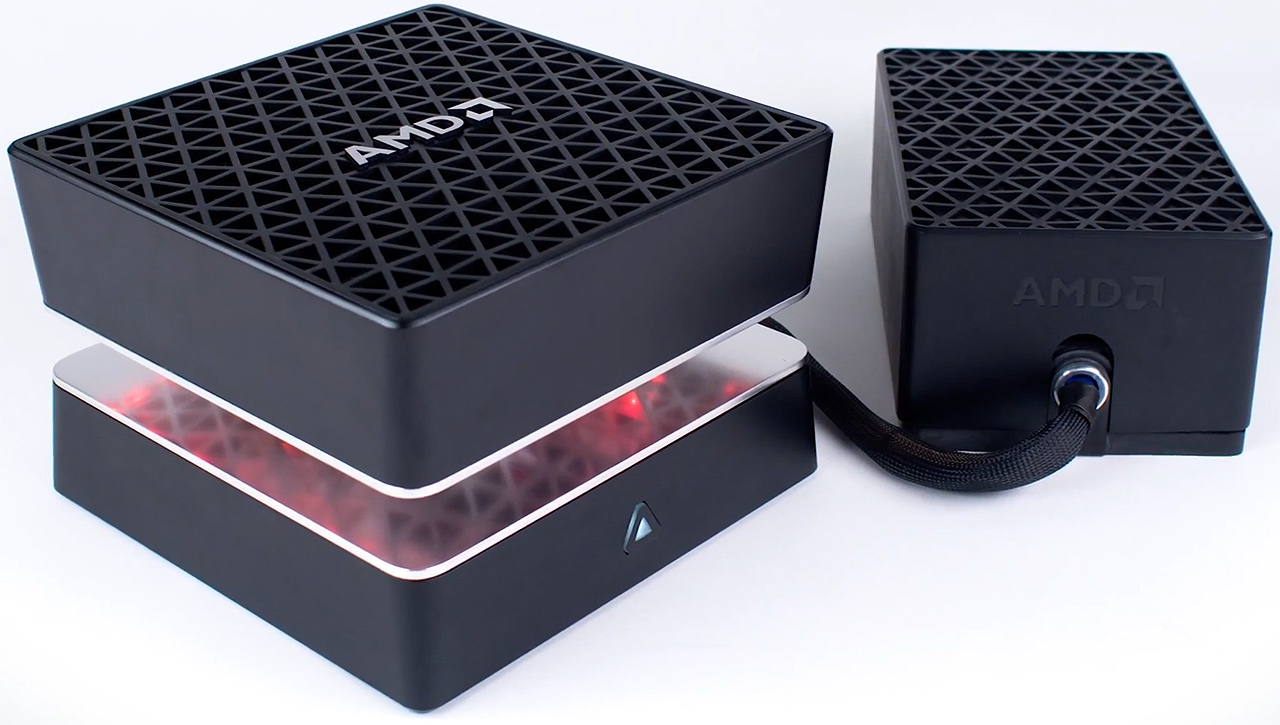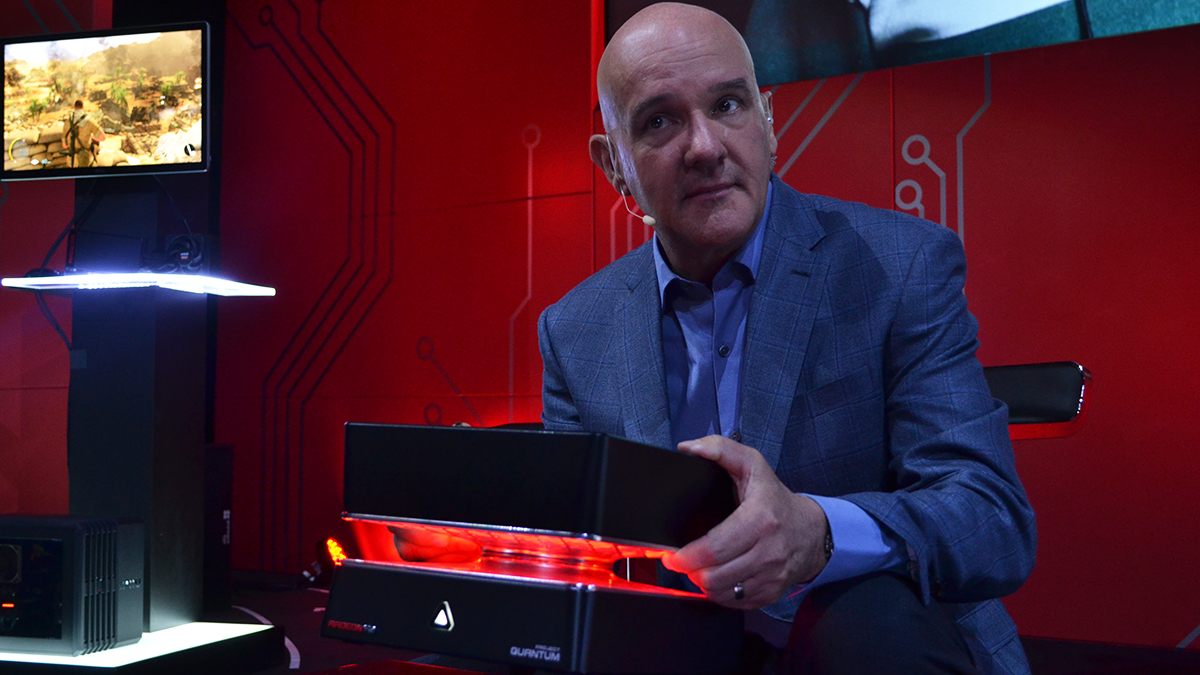AMD Clarifies Why It Uses Intel Core i7 In Its Project Quantum Gaming PC
What's that? AMD is using an Intel CPU in its Project Quantum SFF gaming PC? Here's why.
Recently, AMD showed off its plans for its Fiji based graphics products, among which was Project Quantum – a small form factor PC that packs not one, but two Fiji graphics processors. Since the announcement, KitGuru picked up on something, noticing that the system packs an Intel Core i7-4790K "Devil's Canyon" CPU. We hardly need to point out that it is rather intriguing to see AMD use its largest competitor's CPU in its own product, when AMD is a CPU maker itself.
Though anxious to just jump on the bandwagon and write a quick news post, we took a moment and contacted a couple guys within AMD. They confirmed that Project Quantum uses an Intel CPU, and they explained why:
We have Quantum designs that feature both AMD and Intel processors, so we can fully address the entire market. I'm sure you've heard AMD leaders speak before about how we're driving growth in the company and our key businesses, and that one of the key strategies we have for doing that is listening to customers. You may have heard at the recent AMD financial analyst day that Lisa Su described Job #1 as "Build Great Products." In the case of buyers for systems like Project Quantum, there is a clear preference for choice; they're not interested in a narrow range of computing solutions - they want to pick and choose the balance of components that they want, that are hand-tailored in a world of off-the-rack-suits. With a product as compelling as R9 Fury, we are extremely pleased to enable as much success as we can. There is a range of technology options for CPU in Project Quantum… but the real star is Radeon Fury.
It is clear then that AMD is using Intel processors in its Project Quantum because that's what people want, and that makes perfect sense. It's no secret that AMD's CPUs in the high-end aren't quite up to par with Intel's, and on top of that, in a small form factor such as Project Quantum, you'll want the highest performance per watt in order to squeeze as much performance as possible out of the limited cooling capacity. Heck, if it were to only come with AMD CPU options, we reckon it probably wouldn't sell all that well, so we doff our caps to AMD for swallowing its own pride and building what customers want.
Even so, let's not rule out the possibility of a Project Quantum system with an AMD chip that will perform admirably just yet. A couple weeks back, AMD unveiled the first details on its new Zen x86 cores, which offer a completely new core design, will use the much more energy efficient FinFET technology, and promises to offer a respectable 40 percent increase in IPC over today's Excavator cores. The first units with Zen cores are expected to hit in 2016 (but we don't know exactly when). We're speculating here, but perhaps we'll be seeing them in a second revision of Project Quantum.
In the meantime, sit tight, because our review of the AMD Radeon R9 Fury X is forthcoming.
Follow Niels Broekhuijsen @NBroekhuijsen. Follow us @tomshardware, on Facebook and on Google+.
Get Tom's Hardware's best news and in-depth reviews, straight to your inbox.
Niels Broekhuijsen is a Contributing Writer for Tom's Hardware US. He reviews cases, water cooling and pc builds.
-
usertests Even though the GPU is more important for gaming, AMD's CPUs can't keep up or fit the thermal requirements. It's not news that you can use an Intel CPU and AMD GPU, so this is just pure embarrassment for the company.Reply
Excavator is a joke, Zen can't come fast enough. -
0VERL0RD Hope AMD have plans for full fat Zen cores using HBM 2 & skip DDR4 for CPU & APU's to save more space like Fury aptly demonstrates!Reply -
oczdude8 Its not everyday you see companies swallow their pride in favour of building great products. I think AMD made a great choice.Reply -
silverblue ReplyEven though the GPU is more important for gaming, AMD's CPUs can't keep up or fit the thermal requirements. It's not news that you can use an Intel CPU and AMD GPU, so this is just pure embarrassment for the company.
Except nobody knows how Excavator performs.
Excavator is a joke, Zen can't come fast enough. -
clonazepam Bah they just didn't include their secret intel killer cpu because they didn't wanna get mugged on the way out! /sReply -
troger5troger5 For all you younger folk, Radeon and AMD were separate companies. AMD acquired Radeon if I recall correctly. Intel really never came out with any video cards to talk about gaming wise. It's not easy. I own stuff from both so no bios here.Reply -
jaber2 AMD should stick to what it does best, in this case marketing for Intel, I mean if you can't produce top of the line video cards or cpu's just make lots of them at discounted price, that is how Intel did it.Reply -
jimmysmitty Reply16108299 said:Even though the GPU is more important for gaming, AMD's CPUs can't keep up or fit the thermal requirements. It's not news that you can use an Intel CPU and AMD GPU, so this is just pure embarrassment for the company.
Excavator is a joke, Zen can't come fast enough.
That is if Zen has enough of an IPC boost to keep up with Skylake.
16108348 said:Hope AMD have plans for full fat Zen cores using HBM 2 & skip DDR4 for CPU & APU's to save more space like Fury aptly demonstrates!
I doubt they will ever put memory only on the CPU and not have an expansion option. HBM 2 will allow for up to 8 stacks or 8GB total memory. Even with that there needs to be room for expansion and RAM on the board will be much slower than on package eliminating the benefits when the system has to move to that RAM.
I can see a use for it in APUs but not in enthusiast class CPUs until they can give enough RAM to satisfy the range of memory people use.
16108493 said:For all you younger folk, Radeon and AMD were separate companies. AMD acquired Radeon if I recall correctly. Intel really never came out with any video cards to talk about gaming wise. It's not easy. I own stuff from both so no bios here.
Radeon was never a company it was ATI (Array Technologies Incorporated) who made the Radeon line of GPUs. AMD bought them in 2006 and then incorporated them as AMD Radeon.
Intel has had GPUs but they never released them to the mass market, instead they became powerhouse number crunchers in the HPC market.


